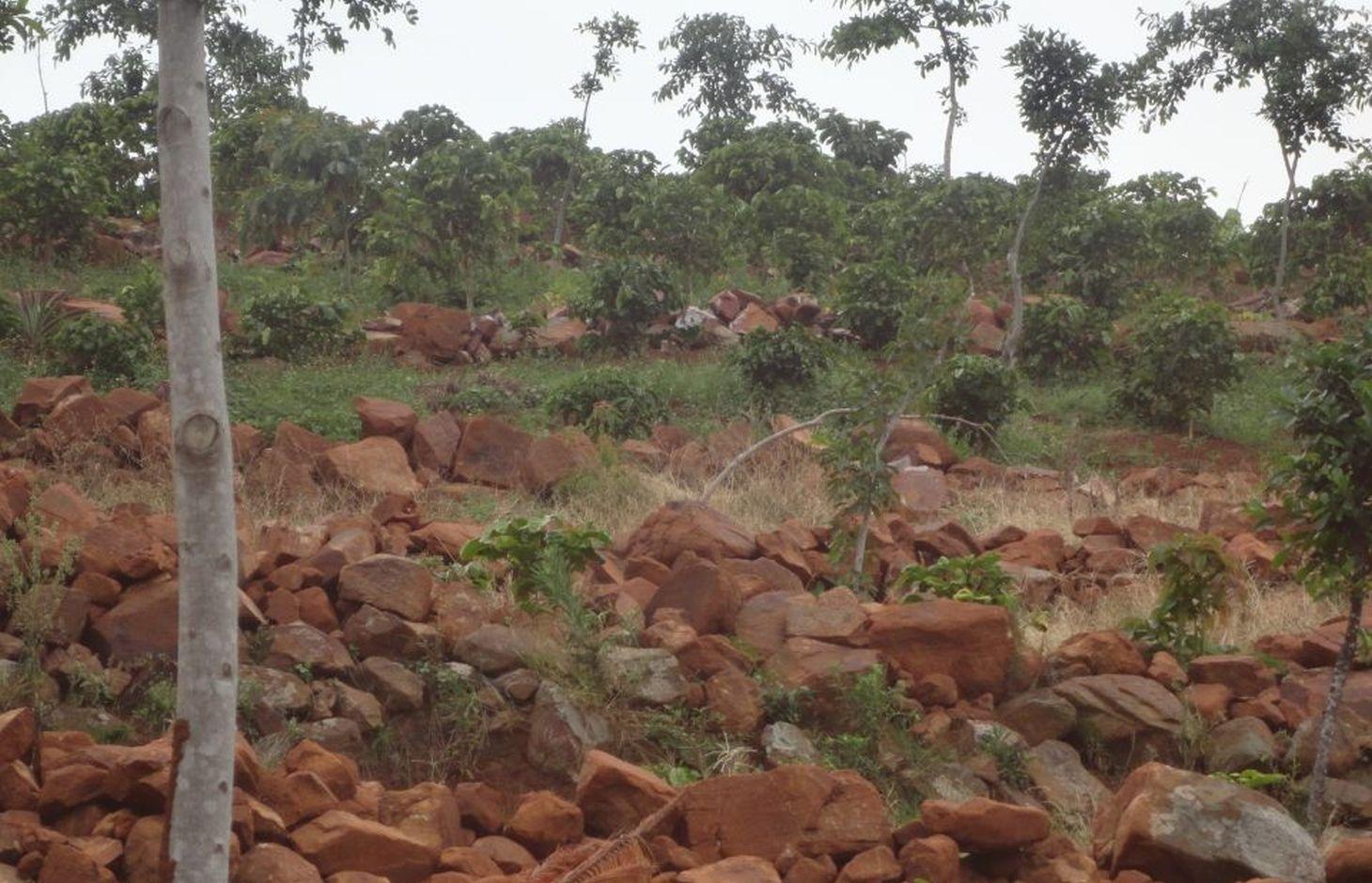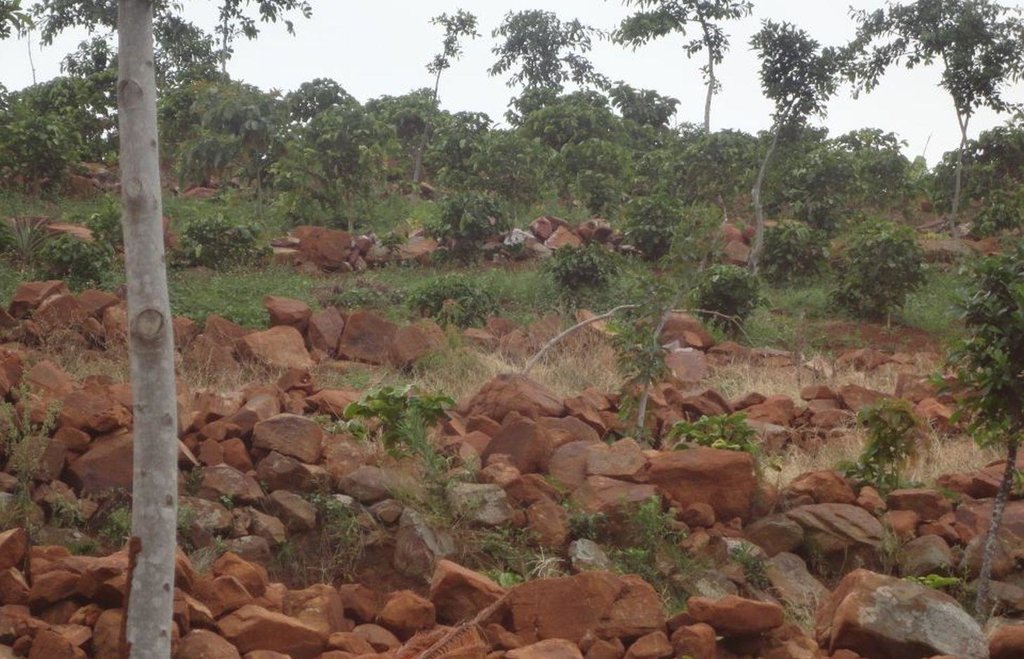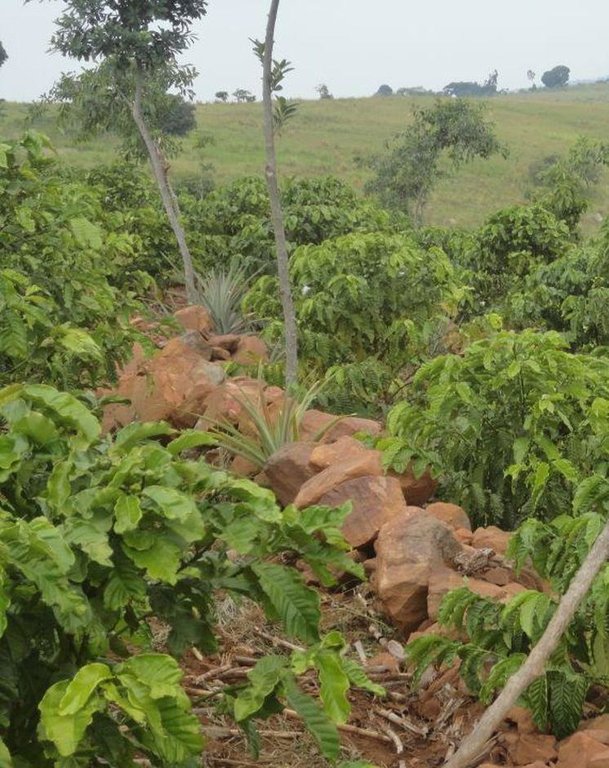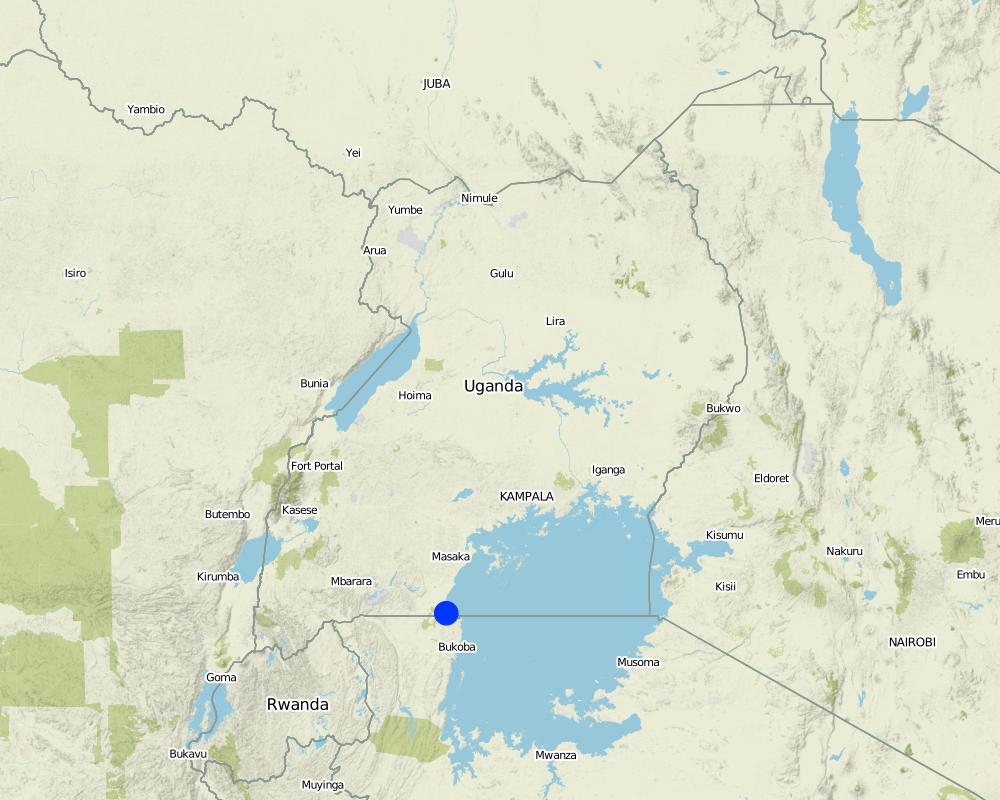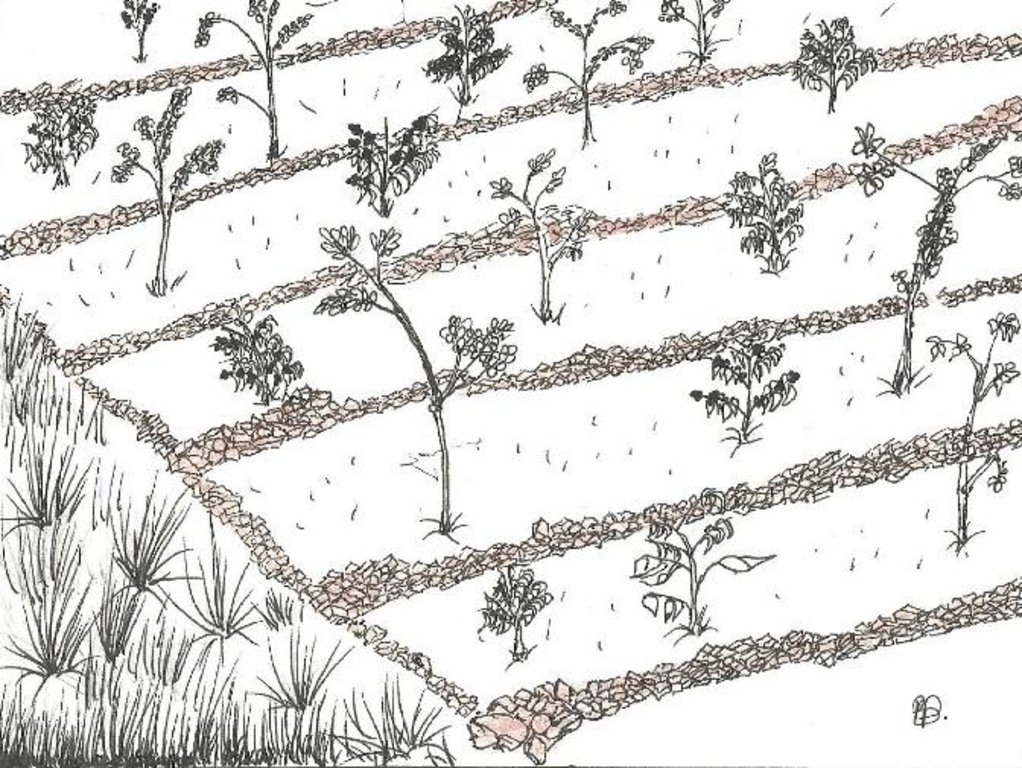Ficus Natalensis Agroforestry System [Uganda]
- Creation:
- Update:
- Compiler: Wilson Bamwerinde
- Editor: –
- Reviewers: Fabian Ottiger, Alexandra Gavilano
Okusimba emituba n'ebimera
technologies_1153 - Uganda
View sections
Expand all Collapse all1. General information
1.2 Contact details of resource persons and institutions involved in the assessment and documentation of the Technology
SLM specialist:
SLM specialist:
SLM specialist:
Lubega Emmanuel
Rakai district
Uganda
Name of project which facilitated the documentation/ evaluation of the Technology (if relevant)
The Transboundary Agro-ecosystem Management Project for the Kagera River Basin (GEF-FAO / Kagera TAMP )Name of the institution(s) which facilitated the documentation/ evaluation of the Technology (if relevant)
Food and Agriculture Organization of the United Nations (FAO) - Italy1.3 Conditions regarding the use of data documented through WOCAT
The compiler and key resource person(s) accept the conditions regarding the use of data documented through WOCAT:
Yes
1.5 Reference to Questionnaire(s) on SLM Approaches (documented using WOCAT)

Community development appraoch [Uganda]
The approach involves the community and other development partners identifying opportunities, challenges and appropriate solutions through collective action.
- Compiler: Wilson Bamwerinde
2. Description of the SLM Technology
2.1 Short description of the Technology
Definition of the Technology:
Ficus natalensis based agroforestry system protects crops on windy hill slopes facing Lake Victoria and reduce runoff towards the meandering Kagera River Valley.
2.2 Detailed description of the Technology
Description:
Ficus natalensis is traditionally scattered in crop fields as a land management practice in central and south-western Uganda. The improved technology designed through community participation involves planting lines of Ficus natalensis along the contour at an interval that enables the tree to provide shade to young crops without depriving them of sunshine. When planted together with coffee trees or in banana plantations, the tall Ficus tree forms the top storey that protects the crop from the hot sun.
Purpose of the Technology: The main purpose of Ficus based agroforestry is to protect the soil from erosion. Within 3 to 5 years the Ficus tree forms a deep root system that stabilizes the soil. In addition, it drops leaves which quickly decay to provide both soil cover and manure thereby increasing the fertility of the soil. The trees provide firewood, fodder for livestock and bark cloth which can be used domestically or sold to supplement household income. They also act as wind breaks.
Establishment / maintenance activities and inputs: Ficus Natalensis is propagated using cuttings from young branches which are planted vertically 6 m apart along a contour. Propagation material is readily available and cheap, making the technology inexpensive to establish. Any annual or perennial crop can be inter-cropped with Ficus spp. provided the tree canopy is managed well. The tree is quite robust and can attain heights of over 20m, with a very extensive canopy if left to grow. Pruning raises its canopy to the desired height above the ground. In its early stages, fencing is required to protect the tree from damage by livestock. Within 12 to 18 months, however, the tree is established enough to withstand browsing. Only simple tools like hoes and garden forks for digging holes/pits are essential for establishment of the technology. The implementation of the technology on steep slopes (> 50%) is not possible without other supportive SLM interventions, in Rakai these include construction of stone lines and mulch application.
Natural / human environment: The pruned branches of Ficus natalensis are used as fuel wood when dry. Therefore scarcity of fuel wood may lead to over-harvesting of branches and destroying the canopy. Nonetheless, the tree regenerates quickly with the coming of the rains. Ficus tree can live for a hundred years.
2.3 Photos of the Technology
2.5 Country/ region/ locations where the Technology has been applied and which are covered by this assessment
Country:
Uganda
Region/ State/ Province:
Uganda
Further specification of location:
Rakai District (Kijonjo Parish)
Comments:
Boundary points of the Technology area: -0.96681 31.69066; -0.96706 31.69111; -0.96717 31.69033; -0.96757 31.69038; -0.96774 31.69073
Total area covered by the SLM Technology is 0.06 km2.
The technology is becoming dominant in Kijonjo parish and other parts of Rakai district especially due to climatic changes that have led to shorter rainy seasons. However, farmers also recognize its potential for soil conservation.
Map
×2.6 Date of implementation
If precise year is not known, indicate approximate date:
- less than 10 years ago (recently)
2.7 Introduction of the Technology
Specify how the Technology was introduced:
- through projects/ external interventions
Comments (type of project, etc.):
Agroforestry is a traditional practice but was reintroduced in a better structured, systematic form by organizations like VI-Agroforestry and Kagera TAMP.
3. Classification of the SLM Technology
3.1 Main purpose(s) of the Technology
- reduce, prevent, restore land degradation
- create beneficial economic impact
3.2 Current land use type(s) where the Technology is applied

Cropland
- Annual cropping
- Perennial (non-woody) cropping
- Tree and shrub cropping
Annual cropping - Specify crops:
- cereals - maize
- legumes and pulses - beans
Perennial (non-woody) cropping - Specify crops:
- banana/plantain/abaca
Tree and shrub cropping - Specify crops:
- coffee, open grown
- figs
- Ficus Spp.
Number of growing seasons per year:
- 2
Specify:
Longest growing period in days: 120 Longest growing period from month to month: February to May Second longest growing period in days: 120 Second longest growing period from month to month: September to December

Forest/ woodlands
Products and services:
- Fuelwood
Comments:
Major land use problems (compiler’s opinion): Severe deforestation as trees were cut down for firewood, charcoal, timber and for agricultural use;
Overgrazing
Major land use problems (land users’ perception): Prolonged dry weather, destructive rainstorms and declining soil fertility
Type of cropping system and major crops comments: Agro-forestry is used in combination with banana and coffee growing.
3.4 Water supply
Water supply for the land on which the Technology is applied:
- rainfed
3.5 SLM group to which the Technology belongs
- agroforestry
3.6 SLM measures comprising the Technology

agronomic measures
- A7: Others

vegetative measures
- V1: Tree and shrub cover

structural measures
- S11: Others
Comments:
Main measures: vegetative measures
Specification of other agronomic measures: mulching (supp.
Specification of other structural measures: stone lines (supp.
Type of vegetative measures: aligned: -contour
3.7 Main types of land degradation addressed by the Technology

soil erosion by water
- Wt: loss of topsoil/ surface erosion

biological degradation
- Bc: reduction of vegetation cover
- Bq: quantity/ biomass decline
Comments:
Main type of degradation addressed: Wt: loss of topsoil / surface erosion, Bc: reduction of vegetation cover, Bq: quantity / biomass decline
Main causes of degradation: soil management (Lack of conservation measures), crop management (annual, perennial, tree/shrub) (Over cultivation), deforestation / removal of natural vegetation (incl. forest fires) (Cutting trees for timber and opening up more agricultural land), over-exploitation of vegetation for domestic use (Cutting trees for fuel wood and charcoal), poverty / wealth, education, access to knowledge and support services
Secondary causes of degradation: other natural causes (avalanches, volcanic eruptions, mud flows, highly susceptible natural resources, extreme topography, etc.) specify (Steep and very steep slopes)
3.8 Prevention, reduction, or restoration of land degradation
Specify the goal of the Technology with regard to land degradation:
- reduce land degradation
4. Technical specifications, implementation activities, inputs, and costs
4.1 Technical drawing of the Technology
Technical specifications (related to technical drawing):
A diagram showing Ficus spp. trees planted to provide shade to coffee trees.
Location: Kijonjo B. village. Rakai
Date: 2013-12-05
Technical knowledge required for field staff / advisors: moderate (Knowledge of which trees will do well with the crops to be cultivated)
Technical knowledge required for land users: low (Land user dedication and a little guidance is enough for the implementation of the technology.)
Main technical functions: control of raindrop splash, control of dispersed runoff: impede / retard, improvement of ground cover, stabilisation of soil (eg by tree roots against land slides), reduction in wind speed, spatial arrangement and diversification of land use
Secondary technical functions: increase in organic matter, increase in nutrient availability (supply, recycling,…), increase of infiltration, increase / maintain water stored in soil, sediment retention / trapping, sediment harvesting, increase of biomass (quantity)
Aligned: -contour
Vegetative material: T : trees / shrubs
Number of plants per (ha): 250
Vertical interval between rows / strips / blocks (m): 20m
Spacing between rows / strips / blocks (m): 2m
Vertical interval within rows / strips / blocks (m): 2m
Width within rows / strips / blocks (m): 20m
Trees/ shrubs species: Ficus natalensis (also serves as perennial fodder), planted in the field using stem cuttings
Perennial crops species: Robusta coffee planted using seedlings bought from specialized nurseries
Slope (which determines the spacing indicated above): 35%
Author:
Byonabye Proscovia, Kagera TAMP, Kabale
4.2 General information regarding the calculation of inputs and costs
other/ national currency (specify):
Ushs
If relevant, indicate exchange rate from USD to local currency (e.g. 1 USD = 79.9 Brazilian Real): 1 USD =:
2500.0
Indicate average wage cost of hired labour per day:
2.00
4.3 Establishment activities
| Activity | Timing (season) | |
|---|---|---|
| 1. | Sourcing planting materials | Beginning of rains |
| 2. | Making pits | Beginning of rains |
| 3. | Planting cuttings | Wet season |
| 4. | Spot weeding | Wet season |
4.4 Costs and inputs needed for establishment
| Specify input | Unit | Quantity | Costs per Unit | Total costs per input | % of costs borne by land users | |
|---|---|---|---|---|---|---|
| Labour | Sourcing planting materials | ha | 1.0 | 30.0 | 30.0 | 100.0 |
| Labour | Making pits | ha | 1.0 | 30.0 | 30.0 | 100.0 |
| Labour | Planting cuttings | ha | 1.0 | 8.0 | 8.0 | |
| Labour | Spot weeding | ha | 1.0 | 8.0 | 8.0 | |
| Equipment | 2 panga | ha | 1.0 | 8.0 | 8.0 | 100.0 |
| Equipment | 2 hoes | ha | 1.0 | 8.0 | 8.0 | 100.0 |
| Plant material | Cuttings (500 stern cuttings) | ha | 1.0 | 30.0 | 30.0 | |
| Total costs for establishment of the Technology | 122.0 | |||||
| Total costs for establishment of the Technology in USD | 0.05 | |||||
Comments:
Duration of establishment phase: 2 month(s)
4.5 Maintenance/ recurrent activities
| Activity | Timing/ frequency | |
|---|---|---|
| 1. | Spot weeding | twice a year |
| 2. | Pruning | Wet season |
| 3. | Removing and processing the bark into bark cloth | Once in 2 years |
4.6 Costs and inputs needed for maintenance/ recurrent activities (per year)
| Specify input | Unit | Quantity | Costs per Unit | Total costs per input | % of costs borne by land users | |
|---|---|---|---|---|---|---|
| Labour | Spot weeding | ha | 1.0 | 8.0 | 8.0 | 100.0 |
| Labour | Pruning | ha | 1.0 | 8.0 | 8.0 | |
| Labour | Removing and processing the bark into bark cloth | ha | 1.0 | 14.0 | 14.0 | |
| Equipment | 1 panga | ha | 1.0 | 4.0 | 4.0 | 100.0 |
| Equipment | 1 hoe | ha | 1.0 | 4.0 | 4.0 | |
| Total costs for maintenance of the Technology | 38.0 | |||||
| Total costs for maintenance of the Technology in USD | 0.02 | |||||
Comments:
Machinery/ tools: The technology only requires simple tools like hoes and pangas.
The costs were calculated for wind breaks and optimum canopy after establishment. Calculations were done in December 2013, considering activities of the previous (September-November) wet season.
4.7 Most important factors affecting the costs
Describe the most determinate factors affecting the costs:
The most important factor affecting cost is labor to transport the bulky stem cuttings to the site. However, Ficus Natalensis is easy to establish and is durable (over 100 years) depending on management. It is extremely hardy and when it grows to 50cm to 100cm stem diameter it can be used for timber or to make dugout canoes. Establishment costs are easily recovered.
5. Natural and human environment
5.1 Climate
Annual rainfall
- < 250 mm
- 251-500 mm
- 501-750 mm
- 751-1,000 mm
- 1,001-1,500 mm
- 1,501-2,000 mm
- 2,001-3,000 mm
- 3,001-4,000 mm
- > 4,000 mm
Specifications/ comments on rainfall:
The area receives two rainy seasons (March-May & September-December)
Agro-climatic zone
- sub-humid
Thermal climate class: tropics. The area lies at the equator.
The area has a dry and a wet season, but other factors influencing its weather include proximity to Lake Victoria and the Kagera River.
5.2 Topography
Slopes on average:
- flat (0-2%)
- gentle (3-5%)
- moderate (6-10%)
- rolling (11-15%)
- hilly (16-30%)
- steep (31-60%)
- very steep (>60%)
Landforms:
- plateau/plains
- ridges
- mountain slopes
- hill slopes
- footslopes
- valley floors
Altitudinal zone:
- 0-100 m a.s.l.
- 101-500 m a.s.l.
- 501-1,000 m a.s.l.
- 1,001-1,500 m a.s.l.
- 1,501-2,000 m a.s.l.
- 2,001-2,500 m a.s.l.
- 2,501-3,000 m a.s.l.
- 3,001-4,000 m a.s.l.
- > 4,000 m a.s.l.
Indicate if the Technology is specifically applied in:
- convex situations
Comments and further specifications on topography:
Altitudinal zone: 1001-1500 m a.s.l (1269-1310m a.s.l.)
Slopes on average: Steep (ranked 1, while technology is good for all kind of slope, the description given here is for a steep slope) and hilly (ranked 2)
5.3 Soils
Soil depth on average:
- very shallow (0-20 cm)
- shallow (21-50 cm)
- moderately deep (51-80 cm)
- deep (81-120 cm)
- very deep (> 120 cm)
Soil texture (topsoil):
- coarse/ light (sandy)
- medium (loamy, silty)
Topsoil organic matter:
- medium (1-3%)
If available, attach full soil description or specify the available information, e.g. soil type, soil PH/ acidity, Cation Exchange Capacity, nitrogen, salinity etc.
Soil depth on average: Shallow (ranked 1) and very shallow (ranked 2). The technology has also adopted to moderate to deep soils to support root development of trees.
Soil texture: Coarse/light (ranked 1, 70% of the soil in the area is sandy) and medium (ranked 2, 20% of the soil is loamy)
Soil fertility: Medium
Topsoil organic matter: Medium (the organic matter is medium but has improved with agroforestry)
Soil drainage/infiltration: Good (soils are manly sandy)
Soil water storage capacity: Low (soils are predominantly sandy)
5.4 Water availability and quality
Ground water table:
5-50 m
Availability of surface water:
poor/ none
Water quality (untreated):
poor drinking water (treatment required)
Comments and further specifications on water quality and quantity:
Ground water table: 5-50 m (The technology does best in soils with ground table of 5-50m to enable root developement)
Availability of surface water: Poor/none (ranked 1, there is no surface water in dry season) and medium (ranked 2, some, in the wet season)
Water quality (untreated): Poor drinking water (treatement required, from unprotected source in swamps)
5.5 Biodiversity
Species diversity:
- medium
Comments and further specifications on biodiversity:
While the surrounding valleys below are swampy and very rich in biodiversity, only a fraction remains at the slopes due to destruction of habitats.
5.6 Characteristics of land users applying the Technology
Market orientation of production system:
- subsistence (self-supply)
- mixed (subsistence/ commercial)
Off-farm income:
- less than 10% of all income
Relative level of wealth:
- average
- rich
Individuals or groups:
- individual/ household
Level of mechanization:
- manual work
Gender:
- women
- men
Indicate other relevant characteristics of the land users:
Land users applying the Technology are mainly common / average land users
Difference in the involvement of women and men: n/a
Population density: 100-200 persons/km2
Annual population growth: 1% - 2%
21% of the land users are rich and own 57% of the land (Business men.).
63% of the land users are average wealthy and own 34% of the land (Teachers).
16% of the land users are poor and own 9% of the land (orphans and widows.).
Off-farm income specification: There is a difference in income levels between those who have implemented the technology and those who have not.
Level of mechanization: Manual work (only manual labour is used-casual labourers)
Market orientation: Subsistence (ranked 1, most produce is for home consumption only surplus is sold) and mixed (ranked 2)
5.7 Average area of land used by land users applying the Technology
- < 0.5 ha
- 0.5-1 ha
- 1-2 ha
- 2-5 ha
- 5-15 ha
- 15-50 ha
- 50-100 ha
- 100-500 ha
- 500-1,000 ha
- 1,000-10,000 ha
- > 10,000 ha
Is this considered small-, medium- or large-scale (referring to local context)?
- small-scale
Comments:
Average area of land owned or leased by land users applying the Technology:
Ranked 1: 0.5-1 ha. For most average income families.
Ranked 2: <0.5-1ha. For the poor.
Ranekd 3: 1-2 ha. For the rich households.
5.8 Land ownership, land use rights, and water use rights
Land ownership:
- individual, not titled
- individual, titled
Land use rights:
- individual
Water use rights:
- open access (unorganized)
Comments:
Most land users have access to untittled land and have open access to water.
5.9 Access to services and infrastructure
health:
- poor
- moderate
- good
education:
- poor
- moderate
- good
technical assistance:
- poor
- moderate
- good
employment (e.g. off-farm):
- poor
- moderate
- good
markets:
- poor
- moderate
- good
energy:
- poor
- moderate
- good
roads and transport:
- poor
- moderate
- good
drinking water and sanitation:
- poor
- moderate
- good
financial services:
- poor
- moderate
- good
6. Impacts and concluding statements
6.1 On-site impacts the Technology has shown
Socio-economic impacts
Production
crop production
Quantity before SLM:
100
Quantity after SLM:
400
Comments/ specify:
coffee and bananas
wood production
Comments/ specify:
For wood fuel (firewood & charcoal). there was almost nothing before.
risk of production failure
Comments/ specify:
conservation of moisture, improved soil fertility
product diversity
production area
Comments/ specify:
Agricultural land on which Ficus is planted
Income and costs
farm income
Comments/ specify:
respondents reported increses in income but not documented.
diversity of income sources
workload
Comments/ specify:
Realization of the benefits has led many farmers to need more help therefore raising the cost of labour
Socio-cultural impacts
food security/ self-sufficiency
Comments/ specify:
incresed agricultural produce.
cultural opportunities
Comments/ specify:
backcloth is used for cultural functions .eg. burying the dead.
conflict mitigation
Improved livelihoods and human well-being
Comments/ specify:
The technology has improved availability of both food and fuel wood. Some products from trees used in agroforestry such as backcloth (Embugo - Luganda) are sold, diversifying household income.
Ecological impacts
Water cycle/ runoff
surface runoff
evaporation
Soil
soil moisture
soil cover
soil loss
soil organic matter/ below ground C
Comments/ specify:
dried tree leaves add humus and organic matter in the soil.
Biodiversity: vegetation, animals
biomass/ above ground C
plant diversity
Comments/ specify:
various tree species are used for agroforestry.
beneficial species
habitat diversity
pest/ disease control
Climate and disaster risk reduction
landslides/ debris flows
Comments/ specify:
Prevention of predisposition towards landslides
wind velocity
Comments/ specify:
windbreaks reduced wind velocity.
Other ecological impacts
Risk of lightening strikes
6.2 Off-site impacts the Technology has shown
downstream flooding
downstream siltation
groundwater/ river pollution
damage on neighbours' fields
6.3 Exposure and sensitivity of the Technology to gradual climate change and climate-related extremes/ disasters (as perceived by land users)
Gradual climate change
Gradual climate change
| Season | increase or decrease | How does the Technology cope with it? | |
|---|---|---|---|
| annual temperature | increase | well |
Climate-related extremes (disasters)
Meteorological disasters
| How does the Technology cope with it? | |
|---|---|
| local rainstorm | not known |
| local windstorm | well |
Climatological disasters
| How does the Technology cope with it? | |
|---|---|
| drought | well |
Hydrological disasters
| How does the Technology cope with it? | |
|---|---|
| general (river) flood | not known |
Other climate-related consequences
Other climate-related consequences
| How does the Technology cope with it? | |
|---|---|
| reduced growing period | well |
6.4 Cost-benefit analysis
How do the benefits compare with the establishment costs (from land users’ perspective)?
Short-term returns:
positive
Long-term returns:
positive
How do the benefits compare with the maintenance/ recurrent costs (from land users' perspective)?
Short-term returns:
very positive
Long-term returns:
very positive
Comments:
The costs for both establishment and maintenance are a small fraction of the benefits accruing from the technology.
6.5 Adoption of the Technology
If available, quantify (no. of households and/ or area covered):
8
Of all those who have adopted the Technology, how many did so spontaneously, i.e. without receiving any material incentives/ payments?
- 91-100%
Comments:
100% of land user families have adopted the Technology without any external material support
8 land user families have adopted the Technology without any external material support
Comments on spontaneous adoption: There is spontaneous adoption of the technology as it builds on traditional farming practices in the area.
There is a strong trend towards spontaneous adoption of the Technology
Comments on adoption trend: High demand for shade-grown coffee and bananas in addition to the highly valued bark cloth used in art and crafts has increased farmer appreciation.
6.7 Strengths/ advantages/ opportunities of the Technology
| Strengths/ advantages/ opportunities in the land user’s view |
|---|
|
Ficus is used to provide backcloth that is sold for the making of Art and crafts and for cultural functions. How can they be sustained / enhanced? Management to accelerate healing of the bark within a shorter period should be investigated |
|
Trees shield crops from dangerous storms /rains and intense sunshine. How can they be sustained / enhanced? Encourage the spread of the canopy |
|
Ficus is good and attractive to birds and insects How can they be sustained / enhanced? Provision of material support in form of seedlings, farm tools for accelerated multiplication |
|
Ficus natalensis leaves are cut and fed to livestock like goats. How can they be sustained / enhanced? Encourage indeginous trees and growing fodder crops such as calliandra and nappier grass |
| Strengths/ advantages/ opportunities in the compiler’s or other key resource person’s view |
|---|
|
Demand for wood fuel is high How can they be sustained / enhanced? Local bye laws should be enacted to control deforestation and encourage tree growing |
|
It improves soil fertility-Ficus natalensis sheds leaves once every year, adding to soil humus. How can they be sustained / enhanced? More guidance should be given to the farmers for sustained spontaneous adoption of the technology |
|
It checks the speed of wind thereby protecting crops. How can they be sustained / enhanced? Other agricultural, ecological and social benefits could be explored in this scenic area facing the Kagera River where it enters Lake Victoria |
|
Stakes made from the Ficus branches can be used to grow climbing plants eg. passion fruits, yams as well as climbing beans How can they be sustained / enhanced? More tree planting should be encouraged |
|
Prevents soil erosion by checking raindrop splash, speed and amount of surface runoff and stabilizes the soil. How can they be sustained / enhanced? Because the ficus tree takes time to establish, other technologies such as trenches and grass strips could be used to reinforce it |
6.8 Weaknesses/ disadvantages/ risks of the Technology and ways of overcoming them
| Weaknesses/ disadvantages/ risks in the land user’s view | How can they be overcome? |
|---|---|
| The trees can hinder crops from light if canopy is dense | Prune periodically to enable other crops access to light |
| Some trees can fall especially during heavy and stormy rains, damaging plants and animals. | cutting excessive branches to reduce the load borne by trees. |
| Trees can attract lightening ,which destroys plants and animals. | Avoid putting animals under tall trees. |
| Weaknesses/ disadvantages/ risks in the compiler’s or other key resource person’s view | How can they be overcome? |
|---|---|
| Some tree species especially with short roots , compete with crops for nutrients. | Planting tree species with deep roots to avoid competition for nutrients. |
| It is a home for weaver birds and caterpillars. | Use scarecrows and biological control. |
7. References and links
7.1 Methods/ sources of information
7.2 References to available publications
Title, author, year, ISBN:
Kagera TAMP project website
Available from where? Costs?
http://www.fao.org/nr/kagera/en/
Links and modules
Expand all Collapse allLinks

Community development appraoch [Uganda]
The approach involves the community and other development partners identifying opportunities, challenges and appropriate solutions through collective action.
- Compiler: Wilson Bamwerinde
Modules
No modules


